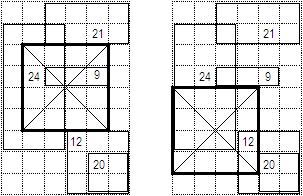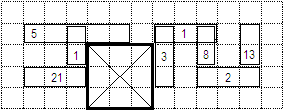IOI '08 P6 - Pyramid Base
View as PDFYou have been asked to find the largest affordable location for constructing a new pyramid. In order to help you decide, you have been provided with a survey of the available land which has been conveniently divided into an by
grid of square cells. The base of the pyramid must be a square with sides parallel to those of the grid.
The survey has identified a set of possibly overlapping obstacles, which are described as rectangles in the grid with sides parallel to those of the grid. In order to build the pyramid, all the cells covered by its base must be cleared of any obstacles. Removing the
obstacle has a cost
. Whenever an obstacle is removed, it must be removed completely, that is, you cannot remove only part of an obstacle. Also, please note that removing an obstacle does not affect any other obstacles that overlap it.
Task
Write a program that, given the dimensions and
of the survey, the description of the
obstacles, the cost of removing each of the obstacles, and the budget
you have, finds the maximum possible side length of the base of the pyramid such that the total cost of removing obstacles does not exceed
.
Constraints
, The dimensions of the grid.
, The cost of removing the
obstacle.
,
coordinates of the leftmost and the rightmost cells of the
obstacle.
,
coordinates of the bottommost and the topmost cells of the
obstacle.
Input Specification
Your program must read from the standard input the following data:
- Line
contains two integers separated by a single space that represent
and
respectively.
- Line
contains the integer
, the maximum cost you can afford (i.e., your budget).
- Line
contains the integer
, the number of obstacles found in the survey.
- Each of the next
lines describes an obstacle. The
of these lines describes the
obstacle. Each line consists of
integers:
,
,
,
, and
separated by single spaces. They represent respectively the coordinates of the bottommost leftmost cell of the obstacle, the coordinates of the topmost rightmost cell of the obstacle, and the cost of removing the obstacle. The bottommost leftmost cell on the grid has coordinates
and the topmost rightmost cell has coordinates
.
Output Specification
Your program must write to the standard output a single line containing one integer, the maximum possible side length of the base of the pyramid that can be prepared. If it is not possible to build any pyramid, your program should output the number .
Subtasks
- (
points)
,
- (
points)
,
- (
points)
,
Sample Input 1
6 9
42
5
4 1 6 3 12
3 6 5 6 9
1 3 3 8 24
3 8 6 9 21
5 1 6 2 20Sample Output 1
4Explanation for Sample Output 1

The figure shows two possible locations for the pyramid's base, both having a side of length .
Sample Input 2
13 5
0
8
8 4 10 4 1
4 3 4 4 1
10 2 12 2 2
8 2 8 4 3
2 4 6 4 5
10 3 10 4 8
12 3 12 4 13
2 2 4 2 21Sample Output 2
3Explanation for Sample Output 2

The figure shows the only possible location for the pyramid's base having a side of length .
Comments